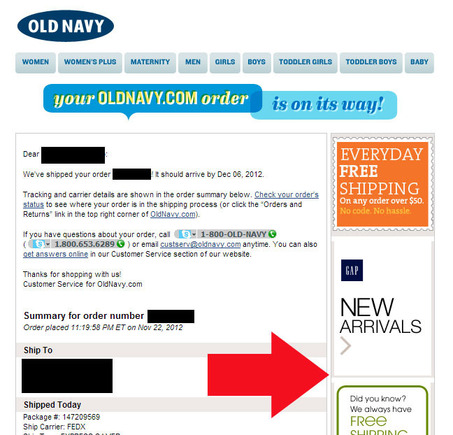Five relatively simple steps could help online retailers significantly improve transactional emails, and, perhaps, earn additional sales.
Transactional or relationship email messages complete, confirm, or provide information about a previously agreed upon transaction. In the ecommerce context, transactional emails most often include order confirmations, shipping notices, and invoices. Email responses to other “transactions” like newsletter subscriptions or entering a contest also fall into this category.
Transactional emails are important. Customers expect a confirmation that an order has been received and are eager to learn when an order has been shipped. These emails frequently enjoy an open rate twice that of purely marketing emails and, according to email service provider Silverpop, can have click-through rates above 20 percent.
1. Make Sure Your Transactional Emails are Deliverable
To be effective, transactional emails must reach the intended recipient. But unfortunately the important task of sending these transactional emails is often left to a web server’s send mail feature and an ecommerce platform’s basic template. Together these factors may mean that some transactional emails are not making past the spam filters at a customer’s Internet Service Provider or in a customer’s mail client.
There are several things that an online retailer marketer can do to improve a transactional email’s deliverability.
- Use a static Internet Protocol address and domain.
- Employ a reputable email service provider.
- Avoid words in subject lines or copy that could trigger a spam filter.
- Monitor and suppress hard bounces.
- Work with Internet Service Providers to be whitelisted.
- Use a DomainKeys Identified Mail — see the Wikipedia definition — to associate the email with your domain.
2. Create a Clear, Action-Based Subject Line
Transactional emails enjoy better open rates than other emails, in part, because customers are anticipating them and want to ensure that the order is moving along as expected.
The email’s subject should clearly state what action a customer took to receive this email and who the email is from.
Positive examples include Playmobil’s order confirmation subject line that reads “Receipt for Your Payment to PLAYMOBIL USA INC.” and Victoria’s Secret’s shipping confirmation subject line that reads, “Victoria’s Secret Shipping Confirmation – Order #123456789.”
Less helpful actual email subject lines include, “Order #1234567 Shipped” — without a merchant’s name — and “Thank You” — without any further information or identification.
3. Make the Content Easy to Read or Scan
Too often transactional emails are built using a script that was included free with an ecommerce platform. While these might include all of the necessary information, the email might not be easy to scan.
Try to lay out transactional emails in a way that lets the customer get all of the necessary information with a quick glance. These emails should be in HTML format. Most modern email clients — including Outlook, Thunderbird, Gmail, and Yahoo! mail — support HTML. An HTML-based email is typically easier to read than a text-only email.
One way to improve readability and scan ability is to format the email in HTML.
4. Including a Follow-Up Offer
A transactional email’s primary purpose is to provide information about or to complete a transaction. But it is acceptable to include a secondary, marketing message.
Consider offering shoppers a discount on their next order, complimentary products, or an opportunity to sign up for an email list.
Old Navy devotes the right-hand column in its transactional emails to marketing.
5. Track, Measure, and Improve Transactional Emails
Finally, too few online retailers track transactional emails with the same vigor applied to marketing and promotional emails.
Monitor deliverability, bounce rates, open rates, and click-throughs. Take steps to improve each of these.




